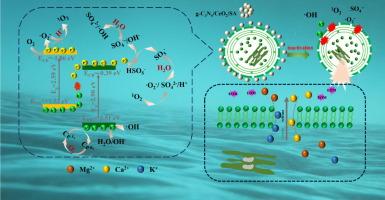Nonradicals-dominated peroxymonosulfate activation of g-C3N4/CeO2 floating beads for enhanced inactivation of M. aeruginosa: Performance studies and mechanistic insights
IF 13.3
1区 工程技术
Q1 ENGINEERING, CHEMICAL
引用次数: 0
Abstract
Microcystis aeruginosa (M. aeruginosa) is a typical harmful algal associated with eutrophication, making the study of its inactivation critical for water restoration. In this research, g-C3N4/CeO2 composites with S-scheme heterojunctions were synthesized and incorporated into sodium alginate (SA) to successfully prepare photocatalytic gel beads with floating capabilities. A photocatalytic persulfate (g-C3N4/CeO2/SA/Vis/PMS) system was developed to systematically investigate the algal inactivation efficacy of floating catalysts. The g-C3N4/CeO2 S-scheme heterojunctions significantly enhanced algal inactivation efficiency, achieving up to 96.65 % inactivation within 80 min. The alterations in algal cell properties during the inactivation process were examined. A decrease in the content of algal bile proteins indicated a disruption of the photosynthetic system within the algal cells, while an increase in the concentrations of K+, Ca2+, and Mg2+ suggested further disruption of algal cell membranes and walls. Additionally, three-dimensional fluorescence spectroscopy (EEM) results indicated that the extracellular organic matter produced during the rupture of algal cells was degraded into humic acid-like substances. The energy bands and electronic structure of g-C3N4/CeO2 were calculated using density functional theory (DFT) to analyze the electron transfer mechanism involved in this process, which is consistent with the S-scheme electron transfer pathway. The effective inactivation of M. aeruginosa was successfully achieved through the combined action of the non-radical 1O2,·O2–, and h+ generated during the photogenerated carrier transfer process. This approach offers a promising strategy for the management of algal blooms in eutrophic waters.

求助全文
约1分钟内获得全文
求助全文
来源期刊

Chemical Engineering Journal
工程技术-工程:化工
CiteScore
21.70
自引率
9.30%
发文量
6781
审稿时长
2.4 months
期刊介绍:
The Chemical Engineering Journal is an international research journal that invites contributions of original and novel fundamental research. It aims to provide an international platform for presenting original fundamental research, interpretative reviews, and discussions on new developments in chemical engineering. The journal welcomes papers that describe novel theory and its practical application, as well as those that demonstrate the transfer of techniques from other disciplines. It also welcomes reports on carefully conducted experimental work that is soundly interpreted. The main focus of the journal is on original and rigorous research results that have broad significance. The Catalysis section within the Chemical Engineering Journal focuses specifically on Experimental and Theoretical studies in the fields of heterogeneous catalysis, molecular catalysis, and biocatalysis. These studies have industrial impact on various sectors such as chemicals, energy, materials, foods, healthcare, and environmental protection.
 求助内容:
求助内容: 应助结果提醒方式:
应助结果提醒方式:


